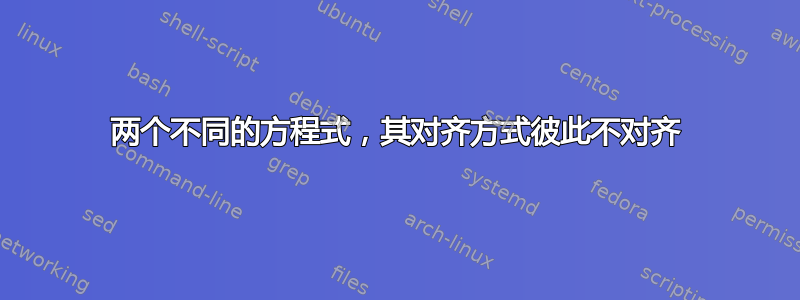
我有两个不同的公式,第一个与第二个不对齐。我首先尝试对齐,但它为每行提供了方程编号。然后我做了
\begin{equation}\begin{aligned} .... \end{aligned}\end{equation}
这是我的代码:
\begin{equation}
\label{eq:chInput:deviceExample}
\begin{aligned}
Touch & = & & \\
< & Manipulation: & \{T_{x},T_{y}\} &, \\
& InputDomain: & \{[0,X_{max}],[0,Y_{max}]\} &, \\
& State: & \{X,Y,Action\} &, \\
& ResolutionFN: & I &, \\
& OutputDomain: & \{[0,X_{max}],[0,Y_{max}]\} &, \\
& Works: & \{\} &>
\end{aligned}
\end{equation}
\begin{equation}
\label{eq:chInput:deviceExampleI}
\begin{aligned}
I & := & &\\
&T_{x}: & \{[0,X_{max}]\} \rightarrow \{[0,X_{max}]\}&, \\
&T_{y}: & \{[0,Y_{max}]\} \rightarrow \{[0,Y_{max}]\}&
\end{aligned}
\end{equation}
问题是,我希望看到 Touch 和我对齐,但它不起作用。
以下是截图

答案1
像这样:
\documentclass{article}
\usepackage{amsmath}
\begin{document}
\begin{align}
&\textit{Touch} = \notag\\
\label{eq:chInput:deviceExample}
&\qquad\begin{aligned}
< & \textit{Manipulation:} & \{T_{x},T_{y}\} &, \\
& \textit{InputDomain:} & \{[0,X_{\textit{max}}],[0,Y_{\textit{max}}]\} &, \\
& \textit{State:} & \{X,Y,\textit{Action}\} &, \\
& \textit{ResolutionFN:} & I &, \\
& \textit{OutputDomain:} & \{[0,X_{\textit{max}}],[0,Y_{\textit{max}}]\} &, \\
& \textit{Works:} & \{\} &>
\end{aligned}\\
&I = \notag\\
\label{eq:chInput:deviceExampleI}
&\qquad\begin{aligned}
&T_{x}: & \{[0,X_{\textit{max}}]\} \rightarrow \{[0,X_{\textit{max}}]\}&, \\
&T_{y}: & \{[0,Y_{\textit{max}}]\} \rightarrow \{[0,Y_{\textit{max}}]\}&
\end{aligned}
\end{align}
\end{document}

笔记:
我放\textit因为文本必须视为文本。否则,字母将被视为数学变量(在产品中)产生不足的间距。
答案2
这是一个使用align作为外部环境、split位于中间和array位于最内部位置的解决方案。最外层的对齐是在符号上执行的=,因为我认为这样做可以更容易地看到哪些元素正在对齐。

\documentclass{article}
\usepackage{amsmath,array}
\begin{document}
\begin{align}
\begin{split}
\label{eq:chInput:deviceExample}
Touch &= \\
&{\quad}<
\begin{array}[t]{@{} >{$\em}l<{$\;:} r @{\;} c@{}}
Manipulation & \{T_{x},T_{y}\}, \\
InputDomain & \{[0,X_{\max}],[0,Y_{\max}]\} , \\
State & \{X,Y,\textit{Action}\} , \\
ResolutionFN & I , \\
OutputDomain & \{[0,X_{\max}],[0,Y_{\max}]\} , \\
Works & \{\}\phantom{,} &> \\
\end{array}
\end{split}\\
\begin{split}\label{eq:chInput:deviceExampleI}
I &= \\
&{\qquad}
\begin{array}[t]{@{} l<{:} r @{}}
T_{x} & \{[0,X_{\max}]\} \rightarrow \{[0,X_{\max}]\}, \\
T_{y} & \{[0,Y_{\max}]\} \rightarrow \{[0,Y_{\max}]\} \\
\end{array}
\end{split}
\end{align}
\end{document}


